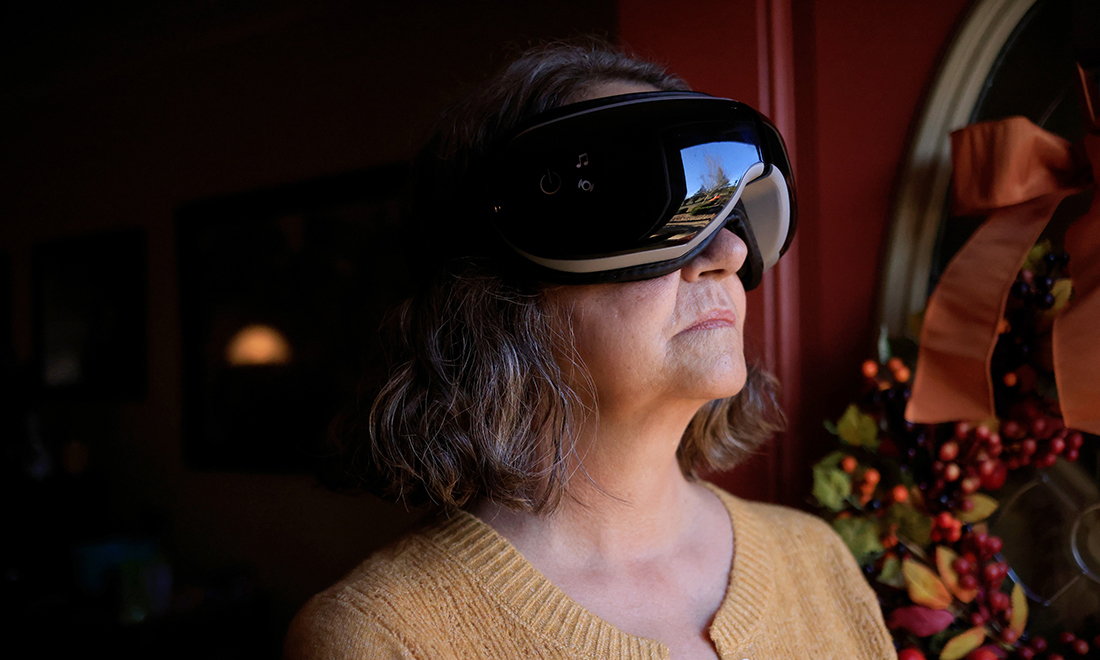
一項新的研究表明,,年齡、性別,、體重指數(shù)和既往病史等因素可能使個人遭受“長期新冠”困擾的風(fēng)險更高,。
3月23日發(fā)表在《美國醫(yī)學(xué)會雜志內(nèi)科學(xué)》(Journal of the American Medical Association Internal Medicine)上的這項英國研究發(fā)現(xiàn),某些人群患新冠后遺癥的風(fēng)險明顯更高,,新冠后遺癥困擾著全球數(shù)百萬人,。
誰最有可能患新冠后遺癥?
? 女性
? 40歲以上
? 肥胖人群
? 吸煙者
? 感染新冠病毒前免疫功能抑制患者
? 因為感染新冠病毒而住院的患者
? 在感染新冠病毒前有以下情況的人:
o 焦慮或抑郁
o 糖尿病
o 哮喘或慢性阻塞性肺病
研究人員調(diào)查了41項已經(jīng)發(fā)表的研究結(jié)果,,這些研究總共涉及超過86萬名患者,。他們發(fā)現(xiàn),上述情況與患新冠后遺癥(新冠后遺癥是指感染新冠病毒三個月后還有癥狀,,這些癥狀持續(xù)三個月或更長時間)的風(fēng)險密切相關(guān),。
研究結(jié)果支持了女性和高齡是患新冠后遺癥的風(fēng)險因素的說法。幾種風(fēng)險類別之間的一個潛在共同點是:預(yù)先存在的炎癥可能會延長期新冠急性期(“甚至是在患者康復(fù)后”),。作者寫道,,就女性而言,激素和肥胖都可能發(fā)揮促炎作用,。
這對大部分人來說不是什么好消息,。然而,也有好消息:研究人員發(fā)現(xiàn),,至少接種兩劑新冠疫苗似乎可以降低患“長期新冠”的風(fēng)險,。他們指出,其他研究也得出了類似的結(jié)論,。其中包括英國國家統(tǒng)計局(U.K. Office of National Statistics)最近的一份報告,,該報告發(fā)現(xiàn),接種兩劑新冠疫苗的人患潛在致殘疾病的風(fēng)險降低了42%,。
專家說,,從持續(xù)咳嗽和疲勞到耳朵麻木和“大腦著火”的感覺,已經(jīng)確定了200多種癥狀,,毋庸置疑,,“長期新冠”不是一種疾病,而是多種疾病,。
一些人認(rèn)為,,真正的“長期新冠”最好被定義為感染新冠病毒后出現(xiàn)的慢性疲勞樣綜合征,類似于感染皰疹,、萊姆病和埃博拉(Ebola)等后可能出現(xiàn)的其他病毒感染后綜合征,。
一些專家說,其他新冠并發(fā)癥,,例如器官損傷,,不應(yīng)該被定義為“長期新冠”,而更適合納入PASC這一更大的范疇,。這一術(shù)語也被稱為新冠后急性后遺癥,,用于涵蓋各種新冠后遺癥,從慢性疲勞樣癥狀和心臟病到持久的肺損傷和尿失禁,、瘙癢和皮膚病損等奇怪的新癥狀,。
凱撒家庭基金會(Kaiser Family Foundation)1月26日的一份報告援引美國疾病控制與預(yù)防中心(U.S. Centers for Disease Control and Prevention)的數(shù)據(jù)稱,截至1月16日,,15%的美國成年人報告在新冠疫情期間的某個階段出現(xiàn)了“長期新冠”癥狀,,6%的人報告這些癥狀持續(xù)時間很長。
報告顯示,,感染過新冠病毒但報告“長期新冠”癥狀的美國人的比例從2022年6月的19%降至今年1月的11%,。(財富中文網(wǎng))
譯者:中慧言-王芳
一項新的研究表明,年齡,、性別,、體重指數(shù)和既往病史等因素可能使個人遭受“長期新冠”困擾的風(fēng)險更高。
3月23日發(fā)表在《美國醫(yī)學(xué)會雜志內(nèi)科學(xué)》(Journal of the American Medical Association Internal Medicine)上的這項英國研究發(fā)現(xiàn),,某些人群患新冠后遺癥的風(fēng)險明顯更高,,新冠后遺癥困擾著全球數(shù)百萬人。
誰最有可能患新冠后遺癥,?
? 女性
? 40歲以上
? 肥胖人群
? 吸煙者
? 感染新冠病毒前免疫功能抑制患者
? 因為感染新冠病毒而住院的患者
? 在感染新冠病毒前有以下情況的人:
o 焦慮或抑郁
o 糖尿病
o 哮喘或慢性阻塞性肺病
研究人員調(diào)查了41項已經(jīng)發(fā)表的研究結(jié)果,,這些研究總共涉及超過86萬名患者。他們發(fā)現(xiàn),,上述情況與患新冠后遺癥(新冠后遺癥是指感染新冠病毒三個月后還有癥狀,,這些癥狀持續(xù)三個月或更長時間)的風(fēng)險密切相關(guān)。
研究結(jié)果支持了女性和高齡是患新冠后遺癥的風(fēng)險因素的說法,。幾種風(fēng)險類別之間的一個潛在共同點是:預(yù)先存在的炎癥可能會延長期新冠急性期(“甚至是在患者康復(fù)后”),。作者寫道,就女性而言,,激素和肥胖都可能發(fā)揮促炎作用,。
這對大部分人來說不是什么好消息,。然而,也有好消息:研究人員發(fā)現(xiàn),,至少接種兩劑新冠疫苗似乎可以降低患“長期新冠”的風(fēng)險,。他們指出,其他研究也得出了類似的結(jié)論,。其中包括英國國家統(tǒng)計局(U.K. Office of National Statistics)最近的一份報告,,該報告發(fā)現(xiàn),接種兩劑新冠疫苗的人患潛在致殘疾病的風(fēng)險降低了42%,。
專家說,,從持續(xù)咳嗽和疲勞到耳朵麻木和“大腦著火”的感覺,已經(jīng)確定了200多種癥狀,,毋庸置疑,,“長期新冠”不是一種疾病,而是多種疾病,。
一些人認(rèn)為,,真正的“長期新冠”最好被定義為感染新冠病毒后出現(xiàn)的慢性疲勞樣綜合征,類似于感染皰疹,、萊姆病和埃博拉(Ebola)等后可能出現(xiàn)的其他病毒感染后綜合征,。
一些專家說,其他新冠并發(fā)癥,,例如器官損傷,,不應(yīng)該被定義為“長期新冠”,而更適合納入PASC這一更大的范疇,。這一術(shù)語也被稱為新冠后急性后遺癥,,用于涵蓋各種新冠后遺癥,從慢性疲勞樣癥狀和心臟病到持久的肺損傷和尿失禁,、瘙癢和皮膚病損等奇怪的新癥狀,。
凱撒家庭基金會(Kaiser Family Foundation)1月26日的一份報告援引美國疾病控制與預(yù)防中心(U.S. Centers for Disease Control and Prevention)的數(shù)據(jù)稱,截至1月16日,,15%的美國成年人報告在新冠疫情期間的某個階段出現(xiàn)了“長期新冠”癥狀,,6%的人報告這些癥狀持續(xù)時間很長。
報告顯示,,感染過新冠病毒但報告“長期新冠”癥狀的美國人的比例從2022年6月的19%降至今年1月的11%,。(財富中文網(wǎng))
譯者:中慧言-王芳
Factors like age, gender, BMI, and pre-existing conditions may put individuals at higher risk for long COVID, according to a new study.
Published on March 23 in the Journal of the American Medical Association Internal Medicine, the U.K.-based study found that certain groups of people are at a significantly higher risk of developing the post-viral condition, thought to affect millions around the world.
Who is most at risk for long COVID?
? Women
? Over 40
? People with obesity
? Smokers
? Those who were immunosuppressed before COVID
? People who were hospitalized with COVID
? People who had the following conditions before COVID:
o anxiety or depression
o Diabetes
o asthma or COPD
Researchers examined the results of 41 published studies, with a combined total of more than 860,000 patients. They found that the aforementioned conditions were strongly associated with a higher risk of long COVID symptoms persisting three or more months after infection.
The results bolster the case that female gender and older age serve as risk factors for developing long COVID. A potential common thread among several risk categories: pre-existing inflammation, which may extend the acute phase of COVID “even after recovery.” In the case of females, hormones might play a role in inflammatory status, while obesity shares a proinflammatory profile with long COVID, the authors write.
That’s not-so-great news for a giant swath of the population. There is good news, however: At least two doses of COVID vaccination seemed to lower the risk of developing long COVID, researchers found. Other studies have come to similar conclusions, they note. They include a recent report from the U.K. Office of National Statistics, which found that those with two doses of COVID vaccine had a 42% lower risk of developing the potentially disabling condition.
With more than 200 symptoms identified—from lingering cough and fatigue to ear numbness and a sensation of “brain on fire”—long COVID is undoubtedly not one but multiple conditions, experts say.
True long COVID, some contend, is best defined as a chronic-fatigue-syndrome-like condition that develops after a COVID infection, similar to other post-viral syndromes that can occur after an infection with herpes, Lyme disease, and Ebola, among others.
Other post-COVID complications like organ damage should not be defined as long COVID and better fit into the larger umbrella category of PASC, some experts say. Also known as post-acute sequelae of COVID-19, the term is used to encompass a wide variety of COVID consequences, from chronic-fatigue-like symptoms and subsequent heart disease to lasting lung damage and odd new symptoms like urinary incontinence, itching, and skin lesions.
As of Jan. 16, 15% of U.S. adults reported having long COVID symptoms at some point in the pandemic, and 6% reported lingering symptoms, according to a Jan. 26 report by the Kaiser Family Foundation, citing data from the U.S. Centers for Disease Control and Prevention.
The percent of Americans who’ve experienced COVID and still report long COVID symptoms dropped from 19% in June to 11% in January, according to the report.






